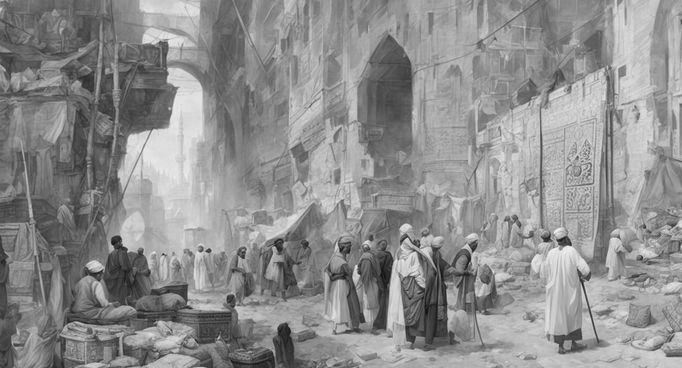Slavery in Islam was never limited to foreigners nor was it ever just practiced on those outside of the Islamic core. Endless Arab slaves dot the pages of the Qu’ran in the first place.
There is a long-running myth, often affirmed by Western scholars, that Arabs themselves were never subjected to slavery and barbarism under Islam. The contrary is the truth. Their status as Muslims or the most ‘superior race’ in the eyes of the Islamic scholars did not always protect them, despite what the Qu’ran ‘claims’ on this subject.
This is highly analogous to the case under Christian Europe, where endless white Christians changed hands up until the early 20th century. The first ‘condemnation’ of slavery from the Church, 1200 years after Constantine, wasn’t in relation to white people they had endlessly enslaved across Europe, but in relation to Native Americans.
Just one example shows Arab women were often abducted from the desert to serve as sex slaves. This was to the point they were treated with highly sexualized stereotypes in contrast with the women of North Africa and white women:
The Arabic women from the desert [are] well experienced, the houris of paradise with red colors, thin and slim waists, adorned necks, honey-colored lips, big eyes, characteristic perfume suitable for all natures, gentle movements, courteous spirits, kind meanings, dry vulvas, soft kisses, and a straight nose. The Maghribī women, with black hair, a kind face, sweet smile, honey-colored and very red lips with a dark shade, and wrists whose beauty is perfected by mirrors and the indigo drawing of the tattoo. The Christians, of diaphanous whiteness, movable breasts, thin bodies, balanced fat, superb flesh in a narrow build of brocades, bodies and backs embellished with beautiful jewels and gorgeous beads; they stand out for the peculiarity of being foreign and for how they blandish […]
Ibn al-Khatib
Under the Abbasid regime, various forms of serfdom emerged analogous to those in Europe that put the Arabs under crushing enslavement. This did not take however in comparison to Europe, as Arabs broadly refused to be engaged with this.
Anatolia also provided a strong resource for slaves, who poured into Syria by the 12th and 13th centuries. Although most slaves continued to be foreigners such as Anatolians, the entire province of Syria by the Middle Ages had begun to function as a glorified slave depot in general. Millions of slaves poured into Syria every year, however, the most vulnerable or opportune Syrian Arabs were simply abducted from their homes and sold on.
The destruction of one of the holiest lands adorned with the most sublime of temples in the Roman period to resemble nothing more than a depot for slavery is an extreme CRIME!

Slave agency was severely constricted in the slave market. Slaves were designated as cattle to be sold and bought, though regulations were designed to prevent the most severe abuses. They had a limited capacity to influence their fate by refusing to cooperate in the inspection and sale process or by facilitating the process by conforming to buyers’ expectations through role-appropriate behaviour such as friendly gestures or displays of physical strength.
[…]
There is some evidence, however, that suggests that such religiously inspired regulations were commonly ignored in slave markets. For example, al-Sakhawi reports that the Ethiopian (habashiyya) child-bearing slave (mustawlada) Jawhara, who belonged to a fifteenth-century Meccan scholar, ‘used to say that her name was Fatima and that she was Jabarti and not Ethiopian’, thus implying that she had been a Muslim and not a Christian when she was captured, making her enslavement illegal.
Domestic Slavery in Syria and Egypt, 1200-1500
While ‘officially’ the enslavement of Arabs was taboo and often discouraged in slave-owning manuals, this rule was commonly ignored in general. Ibn Batutta even met a Syrian girl who spoke his dialect in the court of a black African Muslim king in Mali. On a visit to Mecca, Batutta also described Arab girls as being sold in the market.
Batutta, described by Westerners as a harmless traveller and philosopher, was also a prolific slave owner who took dozens of Arab girls as far as the Maldives with him to sell! Al-Maqrizi also describes incidents of light-skinned Arab girls being sold.
By the Ottoman Empire, some of these concepts had been flipped on their head. By a certain point, despite the ‘ban’ on selling Muslims, the most popular slave in the Islamic world altogether was a Syrian Arab one, with their light-brown skin and dark brown eyes being prized the most. One of the triggers of the Arab revolt during the Ottoman Empire was imperial slavery.
Occasionally, Arabs and Kurds were captured and sold as pagan Yezidis to justify their enslaved status.
NON-ARABS
Much of the taboo of selling Arabs as slaves did not exist in relation to Persian or Iranians whatsoever, who occupied a second-class status. Enslavement of young girls during the 1600s in Persia was so prolific that writers report being unable to find any young girls in vast swathes of the land. By the time the Russians had conquered the Khanate of Khiva in Central Asia, it was home to 200,000 Iranian slaves, a FIFTH of the entire population of the area!
Yezidi girls and boys who were ‘devil worshippers’ were also subjected to endless terror and enslavement in a bid to exterminate them altogether for centuries and centuries. The reader may recall the creation of the Islamic State kicked this into full force in modern times, reviving an ‘ancient’ tradition. Thousands upon thousands of Yezidi women and children were sold into slavery and tortured.
MODERN SLAVERY
Sex trafficking networks of Syrian girls even existed in the early 20th century where they were passed around to other Muslim lands by force. In modern times, the refugee crisis of Syrians, Yezidis and Kurds has also created a gigantic sexual slave market that functions in Lebanon and other countries, including Western ones. The sexual enslavement of Muslim girls of various ethnicities, mostly Pakistani and Arab, in the grooming scandals such as Rotherham and Rochdale is also a notable case in point providing this idea is complete nonsense.
We can therefore dismiss the idea that Islam did not enslave its ‘own’ people – THIS IS A LIE!

